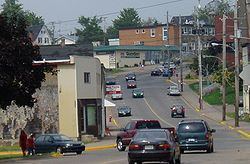Country Canada Founded 1790 Dissolved April 1, 2015 Population 2,743 (2016) Area code Area codes 902 and 782 | Incorporated March 30, 1889 Elevation 199 m Local time Thursday 9:38 AM | |
 | ||
Municipality Municipality of the County of Cumberland Weather -2°C, Wind N at 27 km/h, 86% Humidity | ||
Blizzard of 2013 springhill nova scotia
Springhill is a Canadian community located in central Cumberland County, Nova Scotia.
Contents
- Blizzard of 2013 springhill nova scotia
- Map of Springhill NS Canada
- A drive through springhill nova scotia
- Geography
- Coal mining
- Post industrial adjustment
- Municipal governance
- Transportation
- References
Map of Springhill, NS, Canada
The community was originally named "Springhill Mines." Coal mining lead to economic growth, with its incorporation as a town in 1889. All coal mining ceased in the area by the early 1970s and Springhill entered an economic decline, culminating in the decision to dissolve as a town in 2015, and merge into the Municipality of the County of Cumberland.
The community is famous for both the Springhill Mining Disaster and being the childhood home of international recording star Anne Murray, who is honoured by the Anne Murray Centre, a popular local tourist attraction.
A drive through springhill nova scotia
Geography
Springhill is located on the northwestern edge of the Cobequid Hills midway between the Minas Basin and the Northumberland Strait. The elevation in this area varies from 140 to 185 metres (459 to 607 ft) above sea level. Located in the carboniferous area on the southern side of the Cumberland Coal Basin, Springhill's six main coal seams overlap. The seams, separated by strata of sandstone and shale from 11–110 metres in thickness, were once horizontal, but, because they were raised by internal earth movement, now slope sharply down into the earth. The seams dip to the northwest at an angle of thirty-five degrees.
Coal mining
The first industrial coal mining in the area took place in the 1870s after a rail connection was built by the Springhill and Parrsboro Coal and Railway Company to the newly completed Intercolonial Railway at neighbouring Springhill Junction.
Coal was so prevalent in Springhill that "there was a time when men got coal out of their backyards; shallow pits were found everywhere. In recent years, there have been instances when a homeowner would step out of his door only to find a big gaping hole where his driveway had been. Another part of an old mine had caved in."
Springhill was the site of three devastating mining disasters during the era of large-scale industrial mining from the 1870s until the early 1960s. The first two disasters in 1891 and 1956 were caused by explosions and fires in the mines. The third and final disaster in 1958 accelerated the closure of the largest mines and was what was known as a "bump", or underground upheaval. Small-scale coal mining operations lasted in the town until the 1970s but Springhill took a significant financial hit as it was forced to adjust to a post-industrial service-oriented economy since the closure of the large mines in the late 1950s and early 1960s.
Post-industrial adjustment
The abrupt end of large-scale industrial coal mining presented incredible economic challenges for the region as residents struggled with massive unemployment in the 1960s.
An unexpected legacy and benefit from the abandoned coal mines is being realized in the form of geothermal energy. Since their closure, the mines have filled with ground water which is heated to an average temperature of 18° C (65 °F) by the surrounding earth. Beginning in the late 1980s, this heat source has been exploited by companies located in Springhill's industrial park, situated on the land where the surface facilities of the coal mines were located, reducing winter heating bills substantially.
The provincial and federal government offered economic development assistance and a federal medium-security penitentiary, the Springhill Institution, was built during the late 1960s in an effort to diversify the Springhill economy.
Other companies, such as lead–acid battery manufacturer Surrette Battery and Benjamin Heating Products continue to operate in the community.
Chalice, a charity affiliated with the Roman Catholic Church, is headquartered in Springhill. With over 46,000 children sponsored it is the largest Catholic child sponsorship program in Canada.
Municipal governance
On March 4, 2014, the town's elected council, under the leadership of Mayor Max Snow, announced the decision to give up the municipal incorporation charter for the Town of Springhill effective April 1, 2015. The council stated that the decision was arrived at because the municipality, incorporated in 1889, was facing unprecedented future financial pressures in the form of rising costs for services, salaries and pension obligations, most notably for its municipal police department. At the same time, the municipality was facing a future of decreased revenue due to declining property tax assessments while at the same time having the highest municipal property tax rate in Nova Scotia. Upon dissolution, Springhill became part of the Municipality of the County of Cumberland, comprising approximately 1/5 of the population of that municipality.[6] The decision was criticized by some residents who alleged a lack of consultation by the town council. [7]. However, the decision was also supported by other residents as a good choice. [8]
Transportation
Springhill is 5 km (3.1 mi) south of the Via Rail station in Springhill Junction. It is a stop on request station along the route of the Ocean which runs between Montreal and Halifax.
